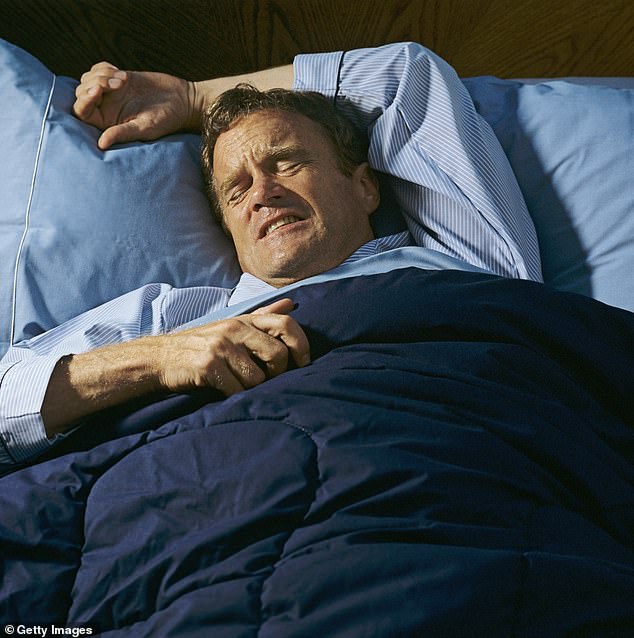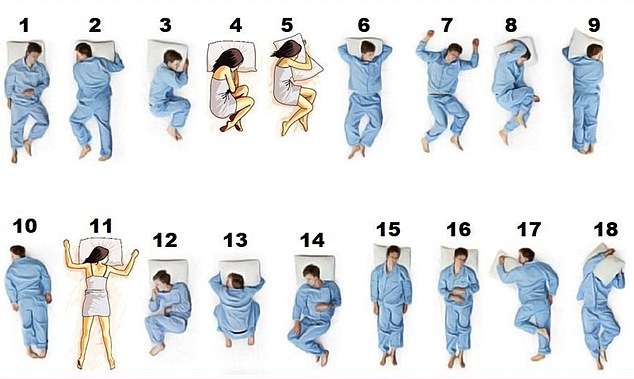Sleeping in a specific position can strain the heart and make you more prone to nightmares, says dream expert
- The position you sleep in can lead to an increased risk of nightmares
- The sleeping position can put pressure on the heart and respiratory tract, which can lead to complaints
- READ MORE: Sleep gurus now say we need SEVEN different types of rest a week
<!–
<!–
<!–
<!–
<!–
<!–
It is known that the position you sleep in can affect the amount of shut-eye you get, and whether or not you have pain in the morning.
However, sleeping in the wrong position could make you more prone to nightmares, a dream expert has revealed.
A study published in the journal Sleep and hypnosisFor example, it turned out that people who sleep on their left side are most likely to have nightmares.
Side sleepers on their left side had a 41 percent chance of having bad dreams, while only 15 percent of those who slept on their right side had them.

The position you sleep in can affect the types of dreams you have, experts say
Theresa Cheung, a dream decoder, told it Tom's guide: “Sleeping on your left side may be linked to nightmares because sleeping on the left side puts more strain on the heart,” she said.
'When there is stress, sleep quality is poor and nightmares are sure to follow.'
A Study from 2018For example, they found that patients who slept on their left side showed changes in their heart activity, which the researchers believed was an indicator of stress. This is because the heart is likely to shift left and right a minuscule amount in this position than in other positions.
Meanwhile, participants who slept on their right sides showed virtually no changes in heart activity.


Sleeping on your left side can put more strain on the heart, putting the body in fight-or-flight mode, which can lead to nightmares
However, it is unlikely to cause any health problems if you do not have pre-existing heart problems. If you have heart disease or heart failure, the change in heart activity can lead to discomfort.
Sleeping on your back can also cause unpleasant dreams, Ms Cheung said. “People who experience nighttime breathing problems are more likely to jump from deep to light sleep and experience anxiety-themed dreams,” she says.
This is common in people with obstructive sleep apnea (OSA), Dr. Lisa Billars, chief of neurology and sleep medicine at Kaiser Permanente in Atlanta, told me. Everyday health.
“For individuals with known or unknown OSA, it is common for the degree of apnea to be worse during supine sleep than during lateral (side) or prone (belly) sleep positions,” she said.
'In people with OSA, the airway collapses or nearly collapses, and this results in a decrease in oxygen and increased carbon dioxide levels in the body.'
These fluctuations can trigger the body's fight-or-flight response. “This physiological response can be experienced as stressful, or the apnea can cause a feeling of outright suffocation,” said Dr. Billars.
“Each of these scenarios could contribute to the development of disturbing dreams or nightmares.”
Ms Cheung also pointed to a 2016 study in the journal Sleep and hypnosiswhich showed that high school students who slept on their stomachs had more “empowering” dreams.
“If you suffer from nightmares, changing your sleeping position can affect your dreams, so you may want to experiment,” Ms Cheung said.
'The best approach is to sleep in a position that is optimal for healthy breathing and is likely to be on your right side, which is potentially better for dreaming.'
Warding off nightmares isn't just about your sleeping position, though.
“The crucial factor when it comes to sleep is always your comfort,” Ms Cheung said.
'Indeed, the best way to influence the content of bad dreams is to always start with your sleep hygiene.
